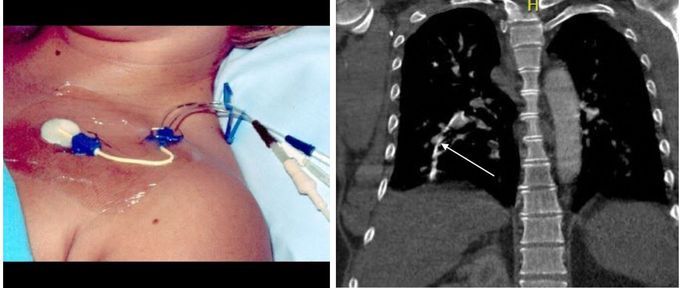


Remnant of Central Venous Catheter can Cause Sepsis
Central venous catheter (CVC) is an indwelling device placed either in internal jugular vein, femoral vein, or subclavian vein. CVC are employed for administration of fluids and medications. Blood can also be drawn from central line to run laboratory investigations. Central vein catheters are superior to peripheral IV lines with respect to large amount of fluid and medication administration. It can be left in body for longer time periods as compared to peripheral lines. Typical immediate complications of placing a central venous catheter are injury to structures adjacent to the catheter, hemorrhage, hemothorax, arrhythmias, and phlebitis. Infection and thrombosis could arise as long-term complications. A journal reported a case of 46 years old gentleman, who presented to ER in with picture of septic shock. Patient was a known alcoholic, a type II diabetic, and had a liver injury from prior laparotomy. Patient also had history of ICU admission 28 years back. On examination, patient was febrile, tachycardiac and hypotensive with deteriorating oxygen saturation. Patient was not responsive to fluid resuscitation hence epinephrine was administered. Broad-spectrum antibiotics were initiated. Laboratory investigations revealed severe metabolic acidosis and acute kidney injury and subsequent anuria. Inflammatory markers were also raised. Total body CT scan was conducted to determine the source of infection. A foreign body was identified in pulmonary arteries . this foreign body was thought to be the remnant of central venous catheter inserted 28 years back. Any surgical intervention was not possible due to hemodynamic instability. The patient, despite of aggressive resuscitation and treatment, could not survive and died within 18 hours of admission. Autopsy revealed presence of foreign body in pulmonary arteries, attached with arterial wall by multiple adhesions. This foreign was the remnant of the catheter that was placed 28 years back. Numerous bacterial colonies were seen on catheter. Enterococcus faecium was cultured from the remnant of CVC, hence, was the source of sepsis. This case report encouraged proper removal of CVC, and vigilant examination of the CVC to look for any missing parts. Source An Unexpected Case of Late Fatal Central Venous Catheter Sepsis: A Case Report https://www.thieme-connect.com/products/ejournals/html/10.1055/s-0040-1713415 Image on right side shows presence of remnant of CVC taken from https://www.thieme-connect.com/products/ejournals/html/10.1055/s-0040-1713415 https://www.youtube.com/watch?v=ubwWEXji79U

